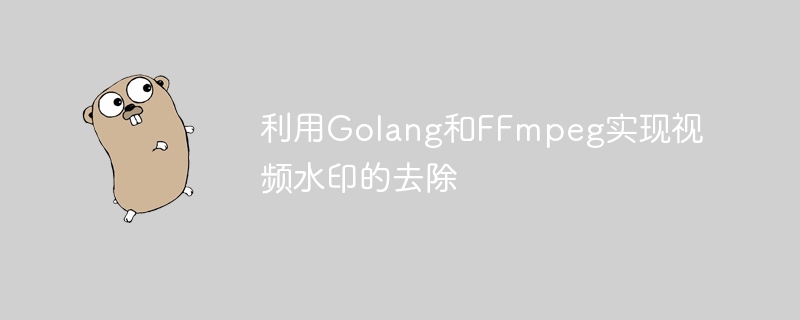

Use Golang and FFmpeg to remove video watermarks
In real life and digital media fields, we often encounter watermarks in videos. Sometimes, these watermarks are added for copyright protection or branding purposes, but in some cases, we may need to remove the watermark from the video to meet specific needs. This article will introduce how to use Golang and FFmpeg to remove video watermarks, and provide specific code examples.
First, we need to install FFmpeg and make sure it can be called from the command line. Depending on the operating system, please refer to the corresponding installation guide for installation and configuration.
Golang is an efficient and concise programming language with rich third-party libraries and powerful concurrency capabilities. We can use Golang to write code to call FFmpeg for video processing.
Before you start, you need to make sure that Golang is installed in your local environment. Then, we can call FFmpeg using Golang in the following way.
First, create a new Golang project and initialize the module:
$ mkdir video_watermark_removal $ cd video_watermark_removal $ go mod init
Then, create a file named main.go in the root directory of the project, and Fill in the following code:
package main
import (
"fmt"
"log"
"os"
"os/exec"
)
func main() {
inputFilePath := "input.mp4"
outputFilePath := "output.mp4"
// 创建一个命令来调用FFmpeg并删除水印
cmd := exec.Command("ffmpeg", "-i", inputFilePath, "-vf", "delogo=x=0:y=0:w=200:h=40", outputFilePath)
// 执行命令
err := cmd.Run()
if err != nil {
log.Fatal(err)
}
fmt.Println("视频水印去除成功!")
}In the above code, we specified the path of the input file input.mp4 and the path of the output file output.mp4. Then, we use the exec.Command() function to create a command object that executes the FFmpeg command. This command will call FFmpeg and use the -vf option to specify a filter and the delogo parameter to remove the watermark. In this example, we assume that the watermark is located in the upper left corner of the video and has a width of 200 pixels and a height of 40 pixels.
Finally, we use the Run() method to execute the command and check the error to determine whether the command was executed successfully.
After finishing writing the code, we can run the code and check the results by following the steps below.
First, rename the video file that needs to be removed as input.mp4 and place it in the same directory. Make sure you are in the root directory of your project on the command line.
Then, run the following command to build and run the project:
$ go build $ ./video_watermark_removal
In the command line, we can see the output of the code run. If all goes well, we will see the output Video Watermark Removal Successful! . In addition, we can also check whether a file named output.mp4 is created in the directory, which is the video file after removing the watermark.
Summary
By using Golang and FFmpeg, we can easily achieve video watermark removal. Whether it is to protect copyright or meet other needs, this method can help us deal with videos containing watermarks. This article provides specific code examples for using Golang to call FFmpeg to remove video watermarks. I hope it will be helpful to everyone.
The above is the detailed content of Use Golang and FFmpeg to remove video watermarks. For more information, please follow other related articles on the PHP Chinese website!
 What does WeChat clone mean?
What does WeChat clone mean?
 netframework
netframework
 How to open the terminal window in vscode
How to open the terminal window in vscode
 What are the free php virtual hosts abroad?
What are the free php virtual hosts abroad?
 What is the use of java
What is the use of java
 What is a relational database
What is a relational database
 How to make pictures scroll in ppt
How to make pictures scroll in ppt
 What are the seven principles of PHP code specifications?
What are the seven principles of PHP code specifications?
 Detailed explanation of nginx configuration
Detailed explanation of nginx configuration




